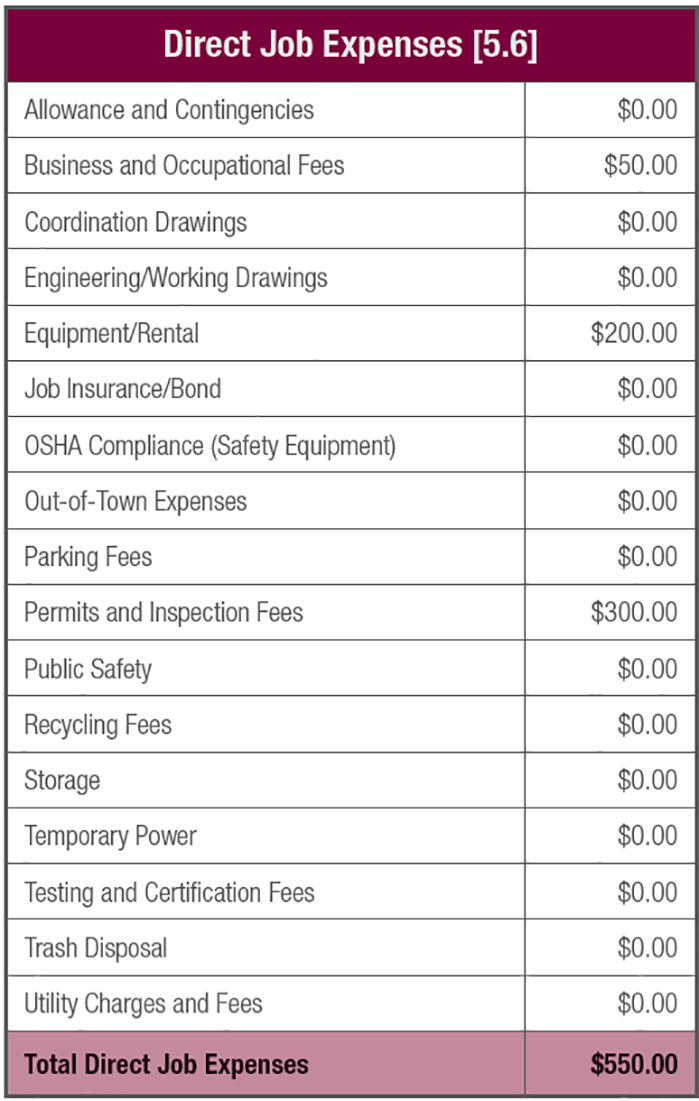|
Estimating is a skill that can make or break a career or
company. Understanding the estimating and bidding
processes is essential for your business to remain
profitable.

This is newsletter #38 in the series. If you have
missed prior newsletters, and are enjoying the series,
we encourage you to purchase the complete Electrical
Estimating Program. Click on the coupon at the bottom
of this page.
|
Determining Break-Even - Direct Job Expenses |
Step three in determining the break-even cost is to account for direct job expenses which are often not shown on the drawings, but probably indicated in the specifications.

Allowances and Contingencies. If the specifications require an allowance to cover the cost of certain items, be sure your bid includes this.
Author's Comment: You might want to consider a contingency clause to protect you against dramatic cost increases in steel conduit and copper wire prices.
Business and Occupational Fees. If you need to purchase a business license or pay an occupational fee for the job, be sure your estimate includes this expense.
Coordination Drawings. It is becoming commonplace for the MEP (Mechanical, Electrical, and Plumbing) trades to complete coordination drawings prior to the actual installation, to account for the clashes and collisions in the limited ceiling areas and mechanical rooms for these infrastructure installations. Be certain to account for CAD personnel, coordination meeting time, and drawing reprographics in your estimate.
Engineering/Working Drawings. If you intend to make changes to the job's design, particularly for value-engineered jobs (an alternate means of accomplishing the same end result), you will need to submit revised drawings, so do not forget to include architectural or engineering costs in your estimate.
Equipment/Rental. Remember to include the cost for equipment, trailers, computers, fax and copy machines, radios and cell phones, office personnel, vehicles, and any other such job related expenses.
Job Insurance/Bond. Be careful, the specifications might require you to secure insurance and/or performance bonding. Do not miss this!
OSHA Compliance. Be sure to include OSHA-related products such as safety rails, straps, personal protective equipment (PPE), and ladder tie-downs.
Out-of-Town Expenses. When bidding a job outside your local area, consider travel expenses, tolls, gas, lodging, meals, Internet access, and long-distance telephone calls or cell phones.
Parking Fees. Parking fees for jobs in major cities can be very expensive!
Permits and Inspection Fees. The cost of permits and special inspections can range from a few hundred to many thousands of dollars.
Author's Comment: Where possible, have the owner and/or contractor be responsible for the cost of permits.
Public Safety. Public safety is a factor, especially when doing work for city, county, state, or for federal governmental agencies. Are you required to purchase or rent safety cones, barricades, or security gates? What about security personnel?
Recycling Fees. Federal and state laws often require the proper disposal of environmentally hazardous products. Watch out for this when disposing of existing electrical products that might contain hazardous chemicals within the product.
Storage. Storage space on the jobsite is often a must, so be sure to include this cost (containers/trailers) in the estimate.
Author's Comment: If the job turns bad, you might not be permitted back on the jobsite to remove your trailer, material, tools, or equipment. If things appear to be going sour, get your trailer and equipment off the job to a safe location as quickly as possible.
Case Study: I know of a few cases where the owners did not pay the electrical contractors and prevented them from entering the premises to retrieve their material, equipment, and tools. By the time the contractors secured a court order requiring the owner to give access, their equipment and tools were long gone”with the owner claiming no knowledge of their whereabouts!
Temporary Power. When estimating temporary power, be sure you are clear in your proposal as to what you intend to provide. Do not agree to vague phrases in the contract such as, Provide temporary power as needed. Be specific in your proposal and indicate the size and voltage of the service, number of poles, lights, receptacles, switches, and any other item that might be required. If your bid does not include maintenance and repairs, or utility connection charges, be sure to say so in your proposal. Sometimes it is more practical to do a take-off of the temporary power during the take-off phase of the estimate.
Case Study: The contract specified that the electrical contractor would supply all temporary power. He failed to visit the jobsite and assumed a basic temporary pole in the estimate. But later (after winning the bid) he found out that no electric utility power was available within two miles of the job and he was required to supply generators for one year, including the cost of fuel and maintenance.
Testing and Certification Fees. Do the job specifications require that electrical systems be tested and/or certified in some manner, like meggering the wiring or ground resistance validation?
Trash Disposal. Who covers the cost of trash that has to be removed from the site? If it is thrown in the dumpster, will you be charged a portion of the overall cost by the general contractor? Make sure your contract is clear on this subject.
Utility Charges and Fees. Who is responsible for paying the electric utility service deposit and monthly electric charge?
|
|
|
We'd love to hear from you about this series, and
the ways you're using it. Send us your comments
and feedback by clicking on Post a Comment below.
Look out for the next part in this series a month
from now, and please share with your colleagues.
|
The above content is extracted from Mike Holt's
Electrical Estimating Program.
|

